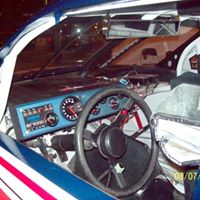Daniel J Johannsen
age ~48
from Des Moines, IA
- Also known as:
-
- Dan Johannsen
- Dan Johnnsen
- Phone and address:
- 2801 42Nd St, Des Moines, IA 50310
Daniel Johannsen Phones & Addresses
- 2801 42Nd St, Des Moines, IA 50310
- Urbandale, IA
- Ankeny, IA
- Ames, IA
- Waterloo, IA
- Moline, IL
- Minneapolis, MN
Us Patents
-
Drawn Cotton Picker
view source -
US Patent:7370460, May 13, 2008
-
Filed:Oct 19, 2006
-
Appl. No.:11/583452
-
Inventors:Mark Samuel Philips - Grimes IA, US
Jeffrey Robert Fox - Minburn IA, US
Daniel John Johannsen - Ankeny IA, US
Kent Cleo Mckee - Mingo IA, US -
Assignee:Deere & Company - Moline IL
-
International Classification:A01D 46/08
-
US Classification:56 28
-
Abstract:One or two conventional picking units are mounted on a two-wheel, high clearance running gear or frame. A two-point hitch is coupled to the draft links of a tractor or an equal-angle hitch is coupled to the tractor drawbar. Hitch and tongue interface on the harvester facilitates sharp turn angles between the implement and the tractor through use of a pivoting member containing the driveline powering the units from the tractor. A center pivot tongue allows offset for appropriate row alignment and provides improved maneuverability and implement steering on headlands and turn rows. A hydraulic cylinder connected to the tongue or a crossed four-bar linkage structure controls tongue angle. A basket is supported at the rear of the frame and the row units are located forwardly of the frame to provide counterbalancing forces about the wheel axis.
-
High Speed Cotton Picker Drum
view source -
US Patent:7614208, Nov 10, 2009
-
Filed:Jun 28, 2007
-
Appl. No.:11/770108
-
Inventors:Daniel John Johannsen - Des Moines IA, US
Jeffrey Robert Fox - Minburn IA, US
Mark Samuel Philips - Akron IA, US -
Assignee:Deere & Company - Moline IL
-
International Classification:A01D 46/16
A01D 46/08
A01D 46/14 -
US Classification:56 47, 56 28, 56 43, 56 48
-
Abstract:To reduce destructive effects of cotton picker high speed drum rotation, rearward spindle tip motion is adjusted in part by angularly positioning the spindles in the picking zone with an improved cam track arrangement. The cam rotates the picker bar about the upright axis of the bar to vary the speed of the spindle tip in the picking zone and allow a higher drum speed. In a first portion of the picking zone the spindle tips are closer together than the spindle bases at the picker bar. The spindle tip spacing in a second portion of the picking zone is approximately equal to spindle base spacing in the extremities. The resulting spindle tip movement facilitates higher cotton picker vehicle ground speed without picking efficiency loss or additional damage to the cotton plants.
-
Tractor Mounted Cotton Harvester
view source -
US Patent:8276356, Oct 2, 2012
-
Filed:Feb 26, 2010
-
Appl. No.:12/713998
-
Inventors:Daniel John Johannsen - Des Moines IA, US
-
Assignee:Deere & Company - Moline IL
-
International Classification:A01F 12/00
-
US Classification:56 172
-
Abstract:A low-cost, highly maneuverable cotton harvester () with a row unit () that effectively follows the ground contour includes frame structure () pivotally connected to the two lower links () of a tractor three-point hitch (). A picking unit () is connected by a linkage structure () to the frame () and is closely coupled behind a rear drive wheel () of the tractor (). A lift arm () extends forwardly and downwardly from an end () pivotally connected to the linkage structure (). The lower forward end of the lift arm includes a non-steerable gauge wheel () generally aligned with the tractor axle (), and a hydraulic cylinder () pivots the lift arm () relative to the linkage structure to adjust row unit operating height and to raise and lower the row unit to and from the field operating position. The gauge wheel axis () is aligned with the axis () of the drive wheel (). A variable speed pulley assembly () synchronizes picker drum speed to ground speed.
-
Low Cost Cotton Harvester With Unit Speed Synchronized To Ground Speed
view source -
US Patent:20110209452, Sep 1, 2011
-
Filed:Mar 1, 2010
-
Appl. No.:12/715237
-
Inventors:Kevin Jacob Goering - Cambridge IA, US
Craig Alan Puetz - Waterloo IA, US
Charles Ostermeier - Slater IA, US
Daniel John Johannsen - Des Moines IA, US -
International Classification:A01D 46/08
B05B 3/00 -
US Classification:56 135, 56 147, 239722
-
Abstract:A low cost cotton harvester () utilizing a tractor chassis () operated in the reverse direction includes a row unit is located forwardly of the drive wheels (), and a single operator station () is situated above the drive wheels (). A basket () is mounted above the engine () and the steerable wheels (). The transmission () on the chassis () includes a mechanical front wheel drive (MFWD) output () located between the drive wheels () and the steerable rear wheels () which is connected to the row unit drive () to synchronize row unit drive speed with tractor drive wheel speed. The harvester fan () is connected to the existing power take off (PTO) shaft () on the tractor chassis () for operation independently of the row unit drive (). Drop wheel axle structure () for the wheels may be used to provide crop clearance and to facilitate use of the chassis as a sprayer when the row unit () is removed. Sprayer pump structure () is driven by the PTO () when the chassis () is converted for spraying.
-
Harvester Steering Probe Assembly
view source -
US Patent:6945019, Sep 20, 2005
-
Filed:Aug 31, 2004
-
Appl. No.:10/930963
-
Inventors:Tom Foster Sonnek - Reinbeck IA, US
Mark Samuel Philips - Grimes IA, US
Daniel John Johannsen - Ankeny IA, US
Scott Francis Stueck - Ankeny IA, US -
Assignee:Deere & Company - Moline IL
-
International Classification:A01D075/28
-
US Classification:56 102F, 56 28, 56 155, 56DIG 11, 172 2, 172 5
-
Abstract:A compact three-bar linkage steering probe assembly, particularly useful with ultra-narrow row cotton harvester units, includes two vertical rocker arms pivotally connected to a harvester row unit at mid-point locations and upper ends connected by a cross link to generally constrain the arms for rocking in unison. Crop guides connected to the lower ends of the rocker arms follow the bases of the plant stalks as the row of plants enter the unit. The vertical arms are maintained within spacer tubes which prevent interference with adjacent rows of plants and which assure the arms are not disturbed by the adjacent rows. A sensor responsive to rotation of the rocker arms is located at the central pivotal connection. Arm leaf springs or a spring biased adjustable upper cross link provides probe flexibility for accommodating different plant stalk sizes.
-
Nozzle
view source -
US Patent:20220288608, Sep 15, 2022
-
Filed:Mar 10, 2021
-
Appl. No.:17/249731
-
Inventors:- MOLINE IL, US
SHRIKANT SADAVARTE - PUNE, IN
NILE T. ACKERMAN - SALIDA CO, US
DANIEL J. JOHANNSEN - DES MOINES IA, US
SHUBHAM DUBEY - AURAIYA, IN -
International Classification:B05B 1/14
A01D 46/10 -
Abstract:Nozzles for an air duct arrangement of an air conveying system may include a first outlet nozzle that is divided into a plurality of chambers are disclosed. The plurality of chambers formed by the outlet provide for a more uniform flow of air exiting the outlet, which generates a greater induced air flow in an associated section of duct. An orientation of a second outlet relative to an inlet of the nozzle provides for a reduced head loss within the nozzle, thereby providing for reduced backpressure within the nozzle and, consequently, a reduced power consumption associated with generating a desired airflow through the nozzle.
-
Nozzle
view source -
US Patent:20230082697, Mar 16, 2023
-
Filed:Nov 22, 2022
-
Appl. No.:18/057838
-
Inventors:- MOLINE IL, US
SHRIKANT SADAVARTE - PUNE, IN
NILE T. ACKERMAN - SALIDA CO, US
DANIEL J. JOHANNSEN - DES MOINES IA, US
SHUBHAM DUBEY - AURAIYA, IN -
International Classification:B05B 1/14
A01D 46/10 -
Abstract:Nozzles for an air duct arrangement of an air conveying system may include a first outlet nozzle that is divided into a plurality of chambers are disclosed. The plurality of chambers formed by the outlet provide for a more uniform flow of air exiting the outlet, which generates a greater induced air flow in an associated section of duct. An orientation of a second outlet relative to an inlet of the nozzle provides for a reduced head loss within the nozzle, thereby providing for reduced backpressure within the nozzle and, consequently, a reduced power consumption associated with generating a desired airflow through the nozzle.
Resumes

Daniel Johannsen
view source
Daniel Johannsen
view source
Daniel Johannsen
view source
Daniel Johannsen
view sourceFlickr
Classmates

Amy Johannsen, Daniel Hig...
view sourceGoogleplus

Daniel Johannsen
Tagline:
13

Daniel Johannsen

Daniel Johannsen
Youtube
Get Report for Daniel J Johannsen from Des Moines, IA, age ~48






